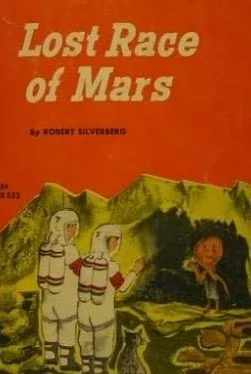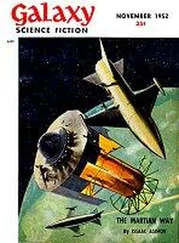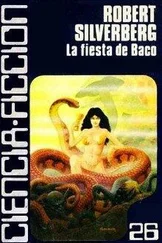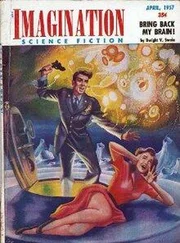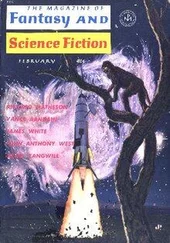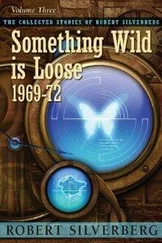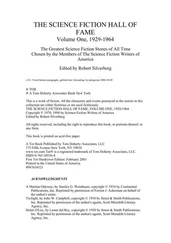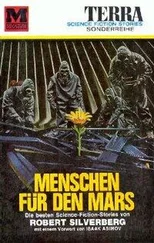He opened the box on his left and drew out a small animal that kicked its legs friskily.
“A kitten!” Jim and Sally exclaimed at once.
John Webster opened the other box. There were two more of the little creatures in there.
Only one empty cage was in the laboratory at the moment. Dr. Chambers gathered up two of the animals and put them inside, while Jim and Sally looked at the third.
It wasn’t exactly a kitten. It had the grace and sleekness of a full-grown cat, but it was no bigger than Chipper had been when he was six months old. It resembled a cat only in it’s litheness and its softness, and in general body shape. It had no claws, though, just flat pads that were probably better for desert travel. It’s eyes, which were large and solemn, were protected by the usual transparent eyelids. Its body, beneath the covering mass of dark fur, was lean. It squirmed and wriggled, and then cuddled itself up contentedly in the crook of Jim’s arm.
Dr. Chambers gave John Webster food coupons, and when he had gone, Jim said, “Dad, are you going to make experiments on all three of these animals?”
“Why, I suppose so. I want to test their metabolism, see what they eat, find out how they react to oxygen loss—is anything the matter?”
“You don’t need all three, do you, Dad?” Sally asked. “I mean, maybe you could spare one—”
Dr. Chambers looked doubtful. Then he began to grin, and a moment later began to laugh. “All right,” he answered finally. “I guess the cause of science can get along with only two of these critters instead of three. Let me examine him. If he’s harmless and friendly, I guess you can have him.”
And that was how Jim and Sally acquired a substitute for Chipper.
It was another hour before the Mars kitten was officially theirs. First Dr. Chambers gave the little creature a thorough examination to make sure it had no concealed poison fangs or other harmful features. Sometime the most innocent-looking animals contain deadly poison. But the Mars kitten got a clean bill of health. It was as harmless as it looked. And it seemed to take to Jim and Sally at once. Because the air in the laboratory had almost then times as much oxygen as the Mars kitten was accustomed to breathing, it got “oxygen drunk” and wobbled about in a silly way.
Mrs. Chambers came upstairs to be introduced to the new pet. “What are you going to call him?” she asked.
“We haven’t decided that yet,” Jim said. The Mars kitten rolled over, sticking his feet up and presenting his stomach to be tickled. The fur on his underside was light orange. Above, he was a very dark maroon-purple that looked nearly black.
“What would be a good name for a Mars kitten?” Sally wondered. “Something astronomical sounding, I guess. Like Orbit or Perihelion or something.”
Jim shook his head. “Too fancy. You wouldn’t call a little ball of fluff like this Perihelion, would you? At least I wouldn’t.”
“You could call him Chipper,” Mrs. Chambers suggested.
“No, that wouldn’t do,” Sally said. “He isn’t anything like Chipper, really. Chipper’s fat and sleepy and lazy, and this one isn’t.”
“I’ve got it!” Jim announced. “We’ll call him Mitten!”
“Mitten?” Sally repeated.
“How come?” Dr. Chambers asked.
Jim grinned. “Two reasons. Look at his feet, with those flat round pads on the bottom. Don’t they look like mittens? And also, it’s a kind of combination word, show for Mars kitten . Mars kitten: Mitten.”
Sally held out for a more Martian-sounding name, but nobody could think of anything that seemed to fit. And so, by general agreement, the Mars kitten became Mitten.
Later that evening the colony newspaper called up. John Webster had told them he had discovered a new life form on the desert, and they wanted information. A reporter came over, took some pictures of the Mars kitten, and wrote down what Dr. Chambers told him.
The next morning there was a story about the Mars kitten on the front page.
A new addition to the slim roster of native Martian life has been made. Dr. John Webster of the engineering staff brought back three specimens of a cat-like creature (see photo at left) which he found in the Xanthe region about seventy miles south of the colony. The animals have been turned over to Dr. Roy Chambers, visiting Earth biologist, who is making a study of desert life on Mars. Two of the animals will undergo observation in Dr. Chambers laboratory. The third, according to Dr. Chambers, is not needed for research purposes and will be adopted as a pet by his children, Jim, six and a half, and Sally, six.
When they saw the article, Jim and Sally were surprised to find their ages given as six and a half and six, and wondered how the reporter could have made such a big mistake.
“Maybe he typed it up wrong,” Sally said.
Jim shook his head and grinned. He had an idea. He scribbled some figures quickly on a piece of paper. “All they did was convert our ages to Mars years,” he said after a moment.
“Remember, the Mars year is 687 days long. That’s—umm—1.88 Earth years. And when you divide our Earth ages by 1.88, it comes out that I’m just under six and a half, and you’re practically six.”
Sally giggled. “That’s almost as bad as being born on Leap Year! In Mars Years Dad’s only in his twenties, then. And Mom’s even younger. I’ll bet they must like that!”
The article in the paper attracted attention in school, too. Jim and Sally received a great many curious stares when they arrived that morning. It seemed as if their classmates wanted to ask them about the Mars kitten, but felt ashamed to because of the way they had treated Jim and Sally.
Ten Navarra broke the ice at lunchtime. He deliberately sat down at Jim’s side and said, “I hear you’ve got a pet, Jim.” For the first time, his voice did not sound unfriendly.
“That’s right,” Jim said, and went on eating.
“I was sort of wondering if—well, if maybe I could come over and have a look at it tonight,”
Ted went on. “I’m interested in animals, you see.”
“Even animals that belong to Earthers?”
Ted reddened. “Look, forget that stuff, will you? We were just showing off a little.”
“And now that I have something you don’t have, you want to make friends? Is that it?”
“Jim, Ted doesn’t want to start a quarrel,” Sally said. “Why not invite him over to visit Mitten?”
“All right,” Jim said. “I guess it won’t hurt.”
That night Ted, Done Bruce, and two other boys came over to see the new animal. They crowded around the furry creature, stroking and tickling it, while Mitten made a soft rumbling sound that was very much like a purr.
“You’re lucky to have a pet like this,” Don Bruce said. “I’ve got a desert tortoise, but he isn’t much fun. He just sits there and stares, and when I try to pet him he pulls his head inside his shell and won’t come out.”
“It’s too bad you can’t take him back with you when you go to Earth,” Ted Navarra said. “It’s against the rules to remove native animals from Mars.”
“I know that,” Jim answered quietly. “But I’ll have a year of fun with him before I have to give him away. Anyhow, I’ve got a pet back on Earth, a real cat.”
The boys left soon afterward. Dr. and Mrs. Chambers were pleased to see that Jim and Sally had finally been visited by some of their classmates, but Jim was less happy. “They made an awful quick turnabout, didn’t they?” he said to Sally. “Yesterday they didn’t want anything to do with us, today we’re all pals. I’m suspicious.”
“Of what?”
“The only reason they’re so friendly is because they’re each hoping to get Mitten when we have to go back to Earth. Ted Navarra practically came right out and said it. Well, they’re all in for a surprise. When we leave, I’m going out in the desert and let Mitten loose. None of them will get him!”
Читать дальше
